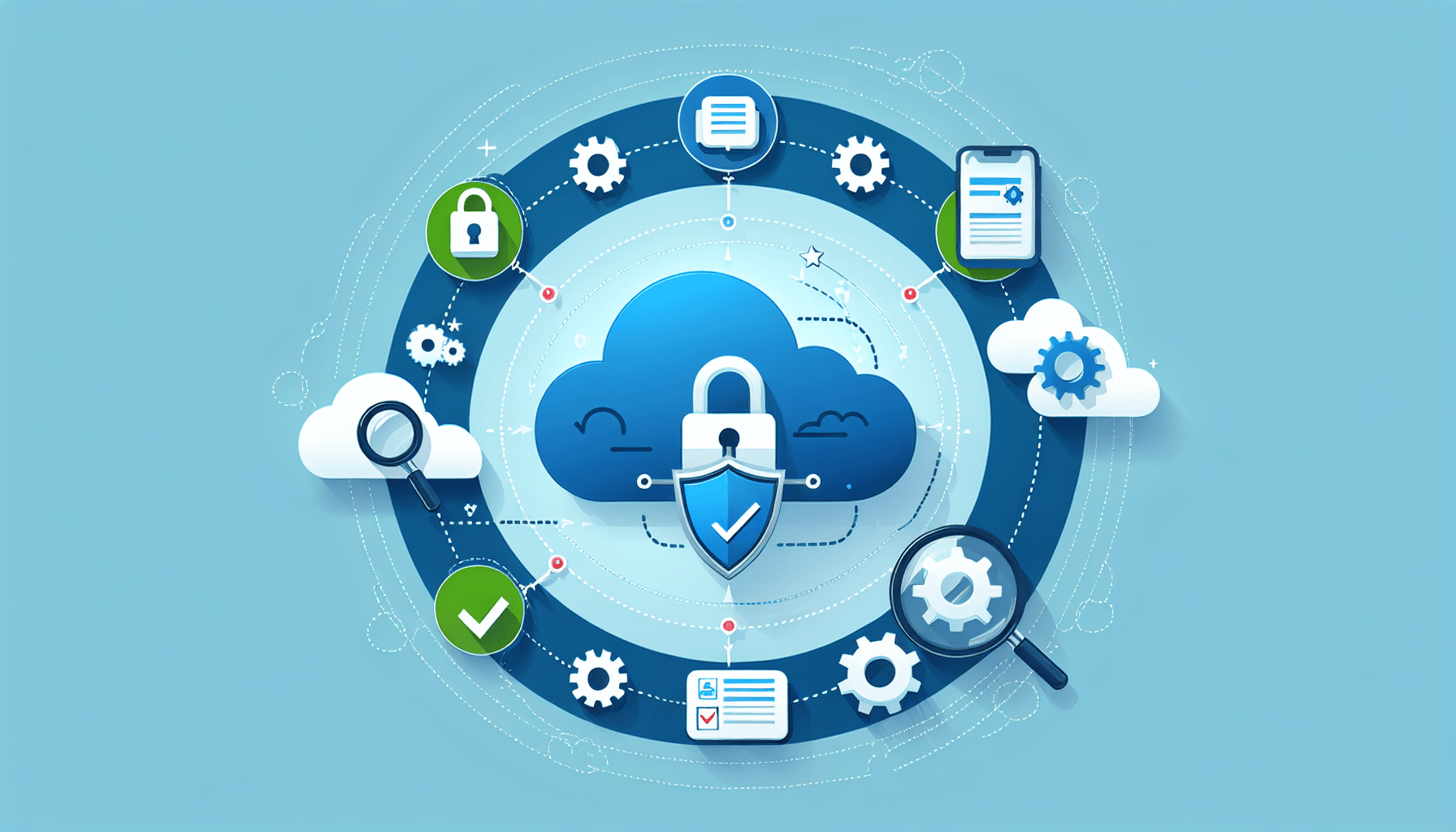In order to ensure the safety and integrity of your cloud-based systems, it is essential to invest in thorough and regular security assessments. These assessments provide a comprehensive evaluation of your cloud infrastructure, identifying potential vulnerabilities and suggesting necessary improvements to mitigate risks. However, budgeting for such assessments can be a complex task, especially considering the evolving nature of cloud technology. In this article, we will explore the best approaches to budgeting for cloud security assessments, equipping you with the knowledge to make informed decisions and safeguard your digital assets effectively.

Evaluate the Importance of Cloud Security Assessments
Cloud security assessments play a vital role in ensuring the protection and integrity of data and systems that are hosted in the cloud. In today’s digital landscape, where cyber threats are evolving and becoming more sophisticated, conducting regular assessments is crucial. By evaluating the importance of cloud security assessments, you can understand the risks of not conducting them and recognize the benefits of investing in such assessments.
Understand the risks of not conducting regular assessments
Not conducting regular cloud security assessments can expose organizations to various risks. One of the most significant risks is the potential for security breaches and data breaches. Without assessing the security of your cloud services and infrastructure, you leave yourself vulnerable to attacks from malicious actors seeking to exploit any vulnerabilities they can find.
Additionally, not conducting assessments can lead to non-compliance with industry regulations and standards. Many industries have specific compliance requirements that organizations must meet. Without regularly assessing your cloud security, you may unknowingly violate these compliance requirements, which can result in fines, penalties, or even legal consequences.
In today’s highly competitive business environment, the reputational damage caused by a security or data breach can be significant. Customers and clients place a high value on the security of their information, and a breach can erode trust and cause severe harm to an organization’s brand and reputation.
Recognize the benefits of investing in cloud security assessments
On the other hand, investing in cloud security assessments offers several benefits to organizations. By conducting regular assessments, you gain insight into the vulnerabilities and weaknesses in your cloud infrastructure and services. This knowledge allows you to implement necessary security measures to mitigate these risks, effectively enhancing the overall security posture of your organization.
Cloud security assessments also provide an opportunity to evaluate and improve your compliance with industry regulations and standards. By conducting assessments, you can identify any gaps in your current security practices and take corrective actions to ensure compliance. This not only helps you avoid potential fines and penalties but also demonstrates to clients and customers that you take their privacy and security seriously.
Furthermore, investing in cloud security assessments can lead to long-term cost savings. By detecting and addressing security vulnerabilities early on, you reduce the likelihood of costly security breaches or data breaches. The financial losses and reputational damage caused by a breach far outweigh the investment required for regular assessments.
Overall, the benefits of investing in cloud security assessments far outweigh the risks of not conducting them. By understanding the importance of these assessments, organizations can make informed decisions and prioritize budget allocation for this critical aspect of their cybersecurity strategy.
Determine the Scope of the Assessment
Before embarking on cloud security assessments, it is essential to determine the scope of the assessment. This involves identifying the cloud services and infrastructure that need to be assessed, considering specific security concerns and compliance requirements, and defining the depth and breadth of the assessment activities.
Identify the cloud services and infrastructure to assess
Start by identifying all the cloud services and infrastructure that are in use within your organization. This includes both internal and external cloud services, such as Infrastructure as a Service (IaaS), Platform as a Service (PaaS), and Software as a Service (SaaS) offerings. Make a comprehensive inventory of all the cloud services and infrastructure to ensure a thorough assessment.
Consider the specific security concerns and compliance requirements
Different organizations have different security concerns and compliance requirements based on their industry, size, and the type of data they handle. Consider these factors when determining the scope of the assessment. For example, if you store sensitive customer information in the cloud, data privacy and encryption may be top priorities. If you operate in a regulated industry, such as healthcare or finance, you may need to comply with specific regulations, such as HIPAA or PCI DSS. Tailor the assessment scope to address these specific concerns and requirements.
Define the depth and breadth of the assessment activities
Determine how deep and extensive the assessment activities should be. This can include evaluating the security configurations of your cloud services, analyzing access controls and authentication mechanisms, reviewing data protection measures, performing vulnerability assessments, and conducting penetration testing. Align the assessment activities with your organization’s risk tolerance and strategic objectives. Consider the level of detail and rigor needed to ensure the assessment provides actionable insights.
By carefully determining the scope of the assessment, organizations can focus their efforts on the areas that matter most to their security and compliance objectives. This helps streamline the assessment process and ensures that resources are used effectively and efficiently.
Research and Select a Reputable Cloud Security Assessment Provider
To carry out comprehensive cloud security assessments, organizations often require the expertise and services of a reputable assessment provider. Researching and selecting the right provider is essential to ensure the effectiveness and reliability of the assessment. The following factors should be considered when evaluating potential assessment providers:
Review the provider’s expertise and experience in cloud security
Look for assessment providers that have specific expertise and experience in cloud security. Assess their knowledge of cloud infrastructure, cloud-native security solutions, and best practices for securing cloud environments. A provider with proven experience in conducting cloud security assessments can bring valuable insights and recommendations to the table.
Consider their certifications and industry recognition
Certifications and industry recognition can serve as indicators of a provider’s credibility and competence in cloud security assessments. Look for certifications such as Certified Cloud Security Professional (CCSP), Certified Information Systems Security Professional (CISSP), or cloud provider-specific certifications like AWS Certified Security – Specialty or Microsoft Certified: Azure Security Engineer Associate. Furthermore, consider any awards or recognitions the provider has received from industry bodies or organizations.
Read customer reviews and testimonials
Gather feedback about the assessment provider from their past and current customers. Read customer reviews and testimonials to evaluate their level of customer satisfaction and the quality of their services. Feedback from other organizations can provide valuable insights into the provider’s professionalism, expertise, and ability to deliver results.
Compare pricing and value for money
Evaluate the pricing models and fee structures offered by different assessment providers. Consider the value for money by comparing the cost of services with the scope and quality of the assessment. While cost is an important factor, prioritize the provider’s expertise and experience over lower-priced options. Investing in a reputable assessment provider can yield greater value in terms of actionable recommendations and improved security posture.
By thoroughly researching and selecting a reputable cloud security assessment provider, organizations can ensure high-quality assessments that address their specific security concerns and compliance requirements. The right provider can serve as a trusted partner in enhancing their cloud security posture.
Estimate the Costs of Cloud Security Assessments
Once a suitable assessment provider has been identified, it is crucial to estimate the costs associated with cloud security assessments. This requires considering various factors, including the pricing models and fee structures of assessment providers, the scale and complexity of the assessment, any additional services or customized requirements, and the frequency of assessments needed.
Understand the pricing models and fee structures of assessment providers
Assessment providers may offer different pricing models and fee structures for their services. Common models include fixed fees, hourly rates, or project-based pricing. Understand how the provider charges for their services and whether they offer any bundled packages or discounts for multiple assessments.
Consider the scale and complexity of the assessment
The scale and complexity of the assessment can significantly impact the costs. Larger organizations or those with extensive cloud infrastructure may require more time and resources to complete the assessment. Additionally, assessing complex or highly customized cloud environments may require specialized expertise or tools, which can add to the overall costs.
Factor in any additional services or customized requirements
Organizations may have specific requirements that go beyond a standard assessment. This can include additional services such as incident response planning, security awareness training, or assistance with compliance audits. Consider these additional services and customized requirements when estimating the costs.
Determine the frequency of assessments needed
The frequency of cloud security assessments can vary depending on the organization’s risk tolerance, regulatory requirements, and the rate of change within the cloud environment. Determine how often assessments need to be conducted and factor that into the cost estimation. More frequent assessments may require a higher budget allocation.
By carefully estimating the costs of cloud security assessments, organizations can allocate their budget effectively and plan for the necessary investments. This ensures that the assessments are carried out without financial constraints and that the organization continues to uphold a strong security posture in the cloud.

Allocate Budget for Cloud Security Assessment Tools
In addition to investing in assessment services, organizations must allocate budget for the necessary tools to facilitate the assessment activities. Cloud security assessment tools can streamline the assessment process, provide in-depth analysis, and aid in identifying vulnerabilities or misconfigurations. Consider the following factors when allocating budget for these tools:
Research and select the appropriate tools for the assessment activities
Identify the specific assessment activities that require tooling support and research the available tools in the market. Look for tools that can address your organization’s security concerns, compliance requirements, and infrastructure components. Consult with the assessment provider to get their recommendations on suitable tools based on their expertise and experience.
Compare the costs and licensing options
Compare the costs of different assessment tools, taking into account factors such as licensing fees, user subscriptions, or usage-based charges. Consider the tool’s feature set, scalability, and compatibility with your cloud environment. Strive for a balance between cost and functionality to ensure you are getting value for your investment.
Consider ongoing maintenance and support expenses
Factor in the costs associated with ongoing maintenance and support for the assessment tools. Some tools may require regular updates, software patches, or technical support agreements. Ensure that the budget allocation covers these expenses to ensure the effective and continued use of the tools.
Include budget for training and skill development
Allocate budget for training and skill development to enhance the competency of the assessment team in using the selected tools. This can include investing in training courses, certifications, or workshops focused on cloud security assessment practices and tool utilization. A well-trained assessment team can maximize the value derived from the tools.
By allocating budget for cloud security assessment tools, organizations can equip their assessment teams with the necessary resources to conduct thorough and effective assessments. These tools can streamline the assessment process, improve accuracy, and provide valuable insights to enhance the overall security of cloud environments.
Consider Long-Term Savings from Cloud Security Assessments
While cloud security assessments require upfront investments, they can result in long-term cost savings for organizations. By considering the potential savings that can be achieved through these assessments, organizations can justify their budget allocations more effectively. Consider the following factors when evaluating the long-term savings:
Recognize potential cost savings from mitigating security breaches
One of the primary objectives of cloud security assessments is to detect and mitigate vulnerabilities and weaknesses in cloud infrastructure and services. By proactively addressing these security risks, assessments can help prevent costly security breaches or data breaches. The financial impact of a breach can include expenses related to incident response, forensic investigations, legal actions, and potential fines. By investing in assessments, organizations can save significant costs associated with breach mitigation.
Calculate potential financial losses and reputational damage
Quantify the potential financial losses and reputational damage that can result from a security or data breach. Consider factors such as lost business opportunities, customer churn, damage to brand image, and public relations efforts required to regain trust. These potential losses can far surpass the investment made in cloud security assessments.
Evaluate the impact of compliance violations on fines and penalties
Non-compliance with industry regulations or standards can result in fines, penalties, or legal consequences. Assess the potential financial impact of non-compliance and how cloud security assessments can help identify and address compliance gaps. By avoiding compliance violations, organizations can save substantial amounts of money that would otherwise be spent on regulatory fines and penalties.
Measure the benefits of early detection and prevention of security incidents
Cloud security assessments provide an opportunity for early detection and prevention of security incidents. By identifying vulnerabilities and weaknesses in their early stages, organizations can implement appropriate controls and measures to prevent potential security incidents. This can save costs associated with incident response, business interruption, and potential damage to systems, applications, or data.
By considering the potential long-term savings resulting from cloud security assessments, organizations can reinforce the importance of budget allocation for these assessments. These long-term savings can far outweigh the upfront investments, making cloud security assessments a financially sound decision.
Collaborate with Stakeholders to Secure Sufficient Budget
Securing sufficient budget for cloud security assessments requires effective collaboration with stakeholders across the organization. By educating executive management and decision-makers about the importance of these assessments, presenting persuasive business cases, and engaging with finance and procurement teams, organizations can ensure the necessary budget allocation. Consider the following strategies:
Educate executive management and decision-makers about the importance of cloud security assessments
Executive management and decision-makers may not always fully understand the importance and value of cloud security assessments. Educate them about the risks associated with not conducting assessments, the potential cost savings, and the positive impact on the organization’s security posture. Provide case studies, industry research, and real-world examples to reinforce the message.
Present a persuasive business case highlighting the potential risks and consequences
Develop a well-structured and persuasive business case to justify the budget allocation for cloud security assessments. Highlight the potential risks and consequences of not conducting these assessments, including the financial impact, reputational damage, and compliance violations. Present data-backed arguments and emphasize the return on investment that can be achieved through cloud security assessments.
Engage with finance and procurement teams to align budget allocation
Collaborate closely with the finance and procurement teams to align budget allocation for cloud security assessments. Clearly articulate the budget requirements and provide supporting documentation, such as cost estimates from assessment providers and tool vendors. Involve these teams in the decision-making process to ensure they have a clear understanding of the strategic importance of these assessments.
Consider seeking funding from external sources or leveraging grants
Explore opportunities for seeking funding from external sources or leveraging grants. Many organizations, industry-specific associations, or government agencies offer grants or financial assistance programs to support cybersecurity initiatives. Research and identify suitable funding options that can supplement the organization’s budget allocation for cloud security assessments.
By collaborating effectively with stakeholders, organizations can secure the necessary budget for cloud security assessments. Effective communication, education, and building a strong business case are key to securing support and resources for this critical aspect of cybersecurity.
Implement Effective Cost Management Strategies
Implementing effective cost management strategies is crucial to ensure that the allocated budget for cloud security assessments is used optimally. By reviewing and optimizing assessment provider contracts, monitoring and managing the usage and costs of assessment tools, leveraging automation and cloud-native security solutions, and exploring bundling or package deals, organizations can maximize the value derived from their budget allocation.
Regularly review and optimize assessment provider contracts
Regularly review and optimize the contracts with assessment providers. Consider factors such as the scope of services, pricing models, service level agreements, and any contractual obligations or commitments. Periodically reassess the performance and value provided by the provider and consider renegotiating contracts or exploring alternative providers if necessary.
Monitor and manage the usage and costs of assessment tools
Keep a close eye on the usage and costs associated with assessment tools. Regularly review usage patterns and analyze whether there is any underutilization or duplication of tools. Optimize the tooling selection and licensing models to ensure that you are only paying for what is necessary and are not overspending on redundant or unused tools.
Leverage automation and cloud-native security solutions for cost efficiency
Leverage automation and cloud-native security solutions to streamline assessment activities and improve cost efficiency. Automating repetitive tasks, such as vulnerability scanning or log analysis, can reduce the manual effort required and free up resources for other critical activities. Additionally, adopting cloud-native security solutions can eliminate the need for on-premises infrastructure, reducing associated costs.
Explore bundling or package deals for cost savings
Consider exploring bundle deals or package offerings from assessment providers or tool vendors. Many providers offer discounts or cost savings when multiple services or tools are purchased together. Collaborate with the assessment provider or tool vendor to explore any available cost-saving options that align with your organization’s needs.
By implementing effective cost management strategies, organizations can ensure that their budget allocation for cloud security assessments is optimized. This allows for more efficient use of resources, cost savings, and a better return on investment.
Track and Monitor Cloud Security Assessment Expenses
Tracking and monitoring cloud security assessment expenses is essential to ensure that the allocated budget is being utilized as planned. By establishing a budget tracking system, monitoring and reviewing actual expenses against the allocated budget, identifying any cost overruns, and regularly reporting the financial status and benefits of the assessments to stakeholders, organizations can maintain financial control and transparency.
Establish a budget tracking system
Establish a system to track and monitor cloud security assessment expenses. This can be as simple as a spreadsheet or as advanced as a dedicated budgeting and financial management software. The system should track expenses related to assessment services, tooling costs, training and skill development, and any ancillary expenses.
Monitor and review actual expenses against the allocated budget
Regularly review and compare actual expenses against the allocated budget. This helps identify any cost overruns or deviations from the original plan. Analyze the reasons behind any discrepancies and take corrective actions to align expenses with the budget. This can involve renegotiating contracts, optimizing tooling usage, or reevaluating the scope of assessments.
Identify any cost overruns and take corrective actions
Promptly identify any instances of cost overruns and take corrective actions to realign expenses with the allocated budget. This may involve revisiting the budget allocation, exploring alternative assessment providers or tools, or adjusting the scope or frequency of assessments. Collaborate closely with relevant stakeholders to address any cost overruns and ensure financial control.
Regularly report the financial status and benefits of the assessments to stakeholders
Provide regular financial reports to stakeholders to keep them informed about the financial status and benefits of the assessments. Highlight any cost savings achieved through early detection and prevention of security incidents, the avoidance of compliance violations, or improvements in the organization’s security posture. This helps demonstrate the impact and value derived from the budget allocation.
By implementing rigorous tracking and monitoring processes, organizations can maintain financial control and effectively manage the expenses associated with cloud security assessments. Regular reporting and transparency foster trust and confidence among stakeholders and ensure that budget allocations are aligned with organizational objectives.
Continuously Improve Budgeting and Spending for Cloud Security Assessments
Continuously improving budgeting and spending for cloud security assessments is crucial to ensure ongoing effectiveness and alignment with organizational goals. By analyzing the effectiveness and return on investment of assessments, seeking feedback from stakeholders and the assessment team, updating the budget allocation based on changing risk profiles and industry trends, and staying informed about new cost-effective technologies and solutions, organizations can adapt and optimize their budget allocation over time.
Analyze the effectiveness and return on investment of assessments
Regularly evaluate the effectiveness of cloud security assessments and measure the return on investment. Assess whether assessments have successfully identified vulnerabilities, improved compliance posture, or prevented security incidents. Consider quantitative and qualitative metrics, such as the number of vulnerabilities mitigated, compliance audit scores, or positive feedback from stakeholders.
Seek feedback from stakeholders and the assessment team
Gather feedback from stakeholders, including executive management, decision-makers, and the assessment team. Engage in post-assessment debrief sessions to identify areas for improvement, learn from the assessment team’s experiences, and gather insights on potential cost-saving measures or process enhancements. Incorporate this feedback into future budgeting and spending decisions.
Update the budget allocation based on changing risk profiles and industry trends
Regularly reassess the budget allocation for cloud security assessments based on changing risk profiles and emerging industry trends. Cybersecurity threats and compliance requirements are continually evolving, requiring organizations to adapt their strategies and investments accordingly. Stay informed about emerging technologies, methodologies, and best practices to ensure that budget allocations align with the current threat landscape and regulatory environment.
Stay informed about new cost-effective technologies and solutions
Stay up to date with new cost-effective technologies and solutions that can enhance the efficiency and effectiveness of cloud security assessments. Monitor the market for advancements in assessment tools, automation capabilities, or cloud-native security solutions. By adopting these technologies, organizations can optimize their budget allocation and achieve greater value for money.
By continuously improving budgeting and spending for cloud security assessments, organizations can adapt to changing circumstances, optimize their investments, and maintain a robust security posture in the cloud. Flexibility, feedback-driven decision-making, and a commitment to staying informed are key to ongoing improvement in budget allocation and spending.
In conclusion, budgeting for cloud security assessments requires a comprehensive understanding of the importance of these assessments, the scope of the assessment activities, the selection of a reputable assessment provider, cost estimation and management strategies, and ongoing evaluation and improvement of the budget allocation. By carefully considering these factors and implementing best practices, organizations can ensure that their cloud environments are secure, compliant, and resilient in the face of evolving cybersecurity threats.



